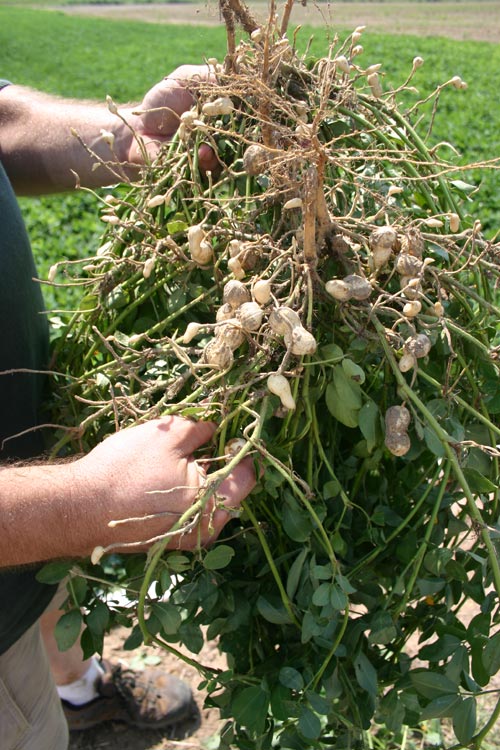September 15, 2010

Some areas in Alabama — including the east-central portion of the state —experienced a record-breaking string of 95 to 100-plus-degree days this summer. This, coupled with drought, has turned a promising spring into a dismal harvest for many producers.
Dry, hot weather definitely will have an impact on this year’s peanut crop, as seen during a mid-August tour through the east-central portion of the state.
“Peanuts are an indeterminate crop, and they’ll grow vines until they are about 100 days old. But the majority of peanuts in east-central Alabama were planted on May 10, and they are small,” said Auburn University Extension peanut agronomist Kris Balkcom, speaking on the East Alabama Crops Tour on Aug. 13.
Time is running out for some peanut growers, he says. “I pulled up some peanuts yesterday in southwest Alabama, and the nuts had turned loose inside the pod. More than likely, those peanuts are done. Even though they’re indeterminate, and can fruit at any time, there’s a certain point that marks an end to the fruiting size. Pegs are being burned off when they hit dirt because the soil temperature is too hot and environmental conditions are not favorable for them to set,” he says.
One good thing about the dry weather this summer is that it has slowed down the development of leafspot disease in peanuts, says Austin Hagan, Auburn University Extension plant pathologist. “If we have fairly constant rainfall, leafspot is maintained at a high level. We saw that last year when it rained during most of the summer in most production areas. This year, we’ve seen a good deal less,” he says.
In dry conditions like those this year, some growers have stretched their leafspot spray intervals to two to three weeks. “Of course if it starts raining, you need to be in front of it. Once we get into early to mid-September, there’s not a lot we can do with the materials that are available. Once the leaves start to come off, they will continue until harvest,” says Hagan.
White mold development
White mold development also drops off considerably as peanuts enter the month of September, he adds. Later planted peanuts have a lower risk of the disease, he says.
Peanut producers in Alabama haven’t seen much tomato spotted wilt virus this year, says Hagan. “This is a good thing, but it doesn’t mean the virus is gone. All we have to do is have a mild winter or two, have good survival with the thrips that vector the virus, and it’ll be back next year. But at least we got a rest from it this year,” he says.
Even in areas of Alabama that have received timely rainfall, the extreme temperatures of this summer are taking a toll on the state’s cotton crop, says Dale Monks, Auburn University Extension cotton agronomist.
“Even in our irrigated cotton, you can look at the tops of the plant and see the damage being done by high temperatures. Look in the middle of the plant, and you’ll find a lot of little squares and bloom tags that never made it to being a boll, and that’s what the heat has done. You can replace rain some with irrigation, but when temperatures reach 95 to 100 degrees, you’ll start shedding fast,” says Monks.
At this time of year, rainfall may help to fill out the bolls, but it also may be a hindrance as defoliation begins, he says.
Potash deficiencies are showing up in some of the state’s cotton crop, says Monks. “The early season cotton shows it first because it’s drawing more out of the soil. If there’s a deficiency, it shows up on early varieties first and then follows into the full-season varieties,” he says.
Soybean crop
Alabama’s soybean crop hasn’t escaped the ravages of a hot, dry production season, says Dennis Delaney, Auburn University Extension soybean agronomist. “It has been a dry year, and we’ve had a lot of reports of soybeans shedding pods and blooms. This is a function of high temperatures and especially high nighttime temperatures. We’re not getting the rainfall and soil moisture to cool the leaves, and soybeans will shed. If we get rain later on, some of this crop might come back. But in a lot of places, they’re setting half a crop. We don’t know if they’ll bloom again and set a crop later on,” he says.
The dry weather has led to fewer disease problems than last year, says Delaney. Asian soybean rust hasn’t been as severe in recent years as was originally feared, he says.
As of mid-August, it had been confirmed in three counties in south Alabama — Baldwin, Mobile and Escambia. “Soybean rust doesn’t like high temperatures or eight full hours of sun. It can infect the plant, but it doesn’t always release new spores. It keeps growing within that leaf until we finally do get some cloudy, wet days. Then it explodes and can spread quickly, usually in mid-August and early September. So late beans would be the most at-risk this year,” he says.
Soybeans that have received rainfall or irrigation and have yield potential should be protected. “For these soybeans, we still recommend putting out a strobilurin fungicide at about the R3, R4 stage. These are preventative fungicides intended to be applied before you get disease and rainfall,” says Delaney.
About the Author(s)
You May Also Like




